#Clypeus fossil
Explore tagged Tumblr posts
Photo

Clypeus Fossil Echinoid - Jurassic, Chedworth Woods, Gloucestershire, UK | 100% Genuine Specimen + COA
A beautifully preserved Clypeus Fossil Echinoid from the Clypeus Grit Member, Salperton Limestone Formation, Jurassic: Chedworth Woods, Gloucestershire, UK. This stunning echinoid fossil is an exceptional addition to any collection, perfect for collectors, educators, and enthusiasts.
✅ 100% Genuine Specimen – Every fossil we sell is authentic and comes with a Certificate of Authenticity. ✅ Discovered by our own expert team – This fossil was found on 22 December 2024 by our dedicated fossil hunters, Alister and Alison. ✅ Expertly cleaned, prepped, and treated – Professionally prepared by Alison to highlight its intricate details and natural structure. ✅ What you see is what you get – The listing photos show the exact specimen you will receive. ✅ Includes size reference – Scale cube in photos = 1cm. Please refer to the images for full dimensions.
About Clypeus Fossil Echinoids:
Clypeus is an extinct genus of echinoid (sea urchin) from the Jurassic period, approximately 165 million years ago. These flattened, disc-like echinoids thrived in shallow marine environments and are commonly found in the Salperton Limestone Formation. Their unique shape and detailed preservation make them a highly sought-after fossil.
This piece is ideal for display, educational purposes, or as a unique gift for fossil lovers and paleontology enthusiasts!
Shipping & Packaging:
🔹 Securely packed for safe transit 🔹 Worldwide shipping available 🔹 Tracked & insured delivery options
Why Buy from Us?
🔹 Trusted Seller – Specializing in fossils, minerals, and natural history specimens. 🔹 Certified Authenticity – Every purchase includes a signed Certificate of Authenticity. 🔹 Ethically Sourced – All our fossils are legally and responsibly collected by our own team.
Bring a piece of prehistoric history into your collection today! 🦕🌍
#Clypeus fossil#Jurassic echinoid#Clypeus Grit fossil#Salperton Limestone echinoid#Chedworth Woods fossil#Gloucestershire fossil#UK fossil#authentic echinoid#fossil collector#echinoid specimen#natural history#prehistoric fossil#fossilized echinoid#sea urchin fossil#geological specimen#unique fossil#fossil display#echinoid sale#echinoid decor#fossil hunting#genuine fossil#echinoid Jurassic#fossil shop#fossil enthusiast#fossil lover gift#rare echinoid#echinoid identification#echinoid UK#echinoid paleontology#echinoid for sale
0 notes
Note
I didn't know you had other prehistoric dragons! Without the pictures, what's the list of them?
I may add more in later drafts but so far:
Late Jurassic Dracomoph (Protodraconis)
Early Cretaceous Dracosuchians (Dracosuchus, Pyrosuchus)
Early Cretaceous Dracovermians (Dracovermis, Tiamat)
Late Cretaceous testudrakoids (Clypeus, Testudisuchus),
Late Cretaceous dracotheroid (Ursadraco)
Late Cretaceous Draconiforms (Longwang, Eondraco and Sinodraco).
Then things get muddy in the Cenozoic, half due to a knowledge gap on my end, and half because dragon skeletons got lighter as they specialized for flight, and magical flight also makes them a host to thaumophagic bacteria which break down the body super fast after death, meaning it is difficult to get a clear fossil record on these animals :)
4 notes
·
View notes
Photo

The Paleontology of Pound Stones
Dairymaids of 18th century England may have been some of the best unintentional paleontologists.
In a time before standardized measurements, these dairymaids often used “pound stones” to weigh out butter and cream. These pound stones, commonly found in the fields of Oxfordshire, were particularly useful because all were uniform in shape, size and weight. Dairymaids recognized the practical value of a pound stone, but it would be a few years before anyone realized their scientific importance.
What were these unique rocks that aided rural dairy farmers? Pound stones were circular, often flat on the bottom, had 5-fold symmetry, and closely resembled a familiar living creature…the sea urchin. Pound stones, or Chedworth buns as they were sometimes called, turned out to be fossilized sea urchins.
As scientific discovery continued to progress, geologists realized that these useful pound stones were not only weights, but signs of ancient oceans that once covered England. This particular species of urchin, Clypeus Ploti, is found in Jurassic limestones and is still a valuable chunk of history for fossil collectors today.
-CM
Photo courtesy of Flickr user Rockman of Zymurgyhttp://bit.ly/1A6K2FA
131 notes
·
View notes
Text
Cmdr H of the Woods’ logbook, May 3309
03 May 3309 Eta Sagittarii I’ve spent the past few days hopping around nearby systems, collecting plants and rocks with funny shapes. I have to say, exiting hyperspace right in front of a giant star always makes a bit of an impression. I landed on a very hot planet, AB2, and then went to take a look at the view from the dusty and rocky rings around planet AB5. The giant star was shining through the dust, which was a lovely sight. I realised that the tiny spot I could see in front of η Sagittarii A was actually... another star. A brown dwarf, which barely looked bigger than a planet. In fact, it’s only about 4 times bigger than the largest planet in this system. Picked up an occupied escape pod and a black box, which I found floating in space next to the 3rd star in this system, and dropped them at the nearest station.
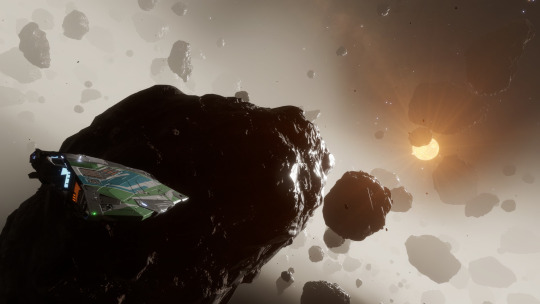
Rukbat After a visit in Kaus Australis (also known as Epsilon Sagittarii), I found myself in Rukbat (Alpha Sagittarii), where a message flashed on my HUD, informing me that I was visiting a system with a neutron star for the first time. I might need to get some maintenance done on my systems, because I know I visited Jackson’s Lighthouse months ago with CMDR Curious Sparrow.
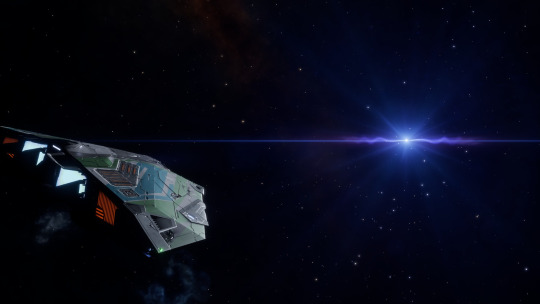
Zeta Coronae Austrinae After Delta Coronae Austrinae, another giant star, I am now in Zeta Coronae Austrinae, which marks a deviation from my exploration of the Sagittarius constellation, as I am now in the Corona Australis constellation. And I just realised, as I was looking at my galmap and wondering why there were no traces of human population, that I have accidentally.. left the Bubble. Well, only kind of, because civilisation is not far, but still. Oops.
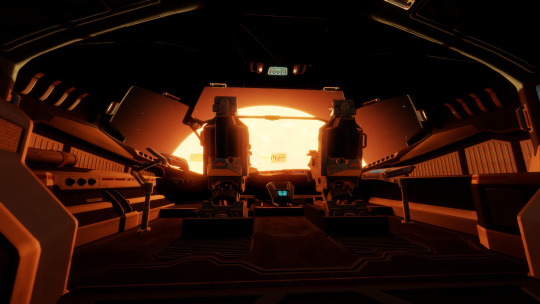
04 May 3309 HIP 95726 There was fungoida on this planet and it was only growing on the dark side, at the bottom of a canyon. Everything was pitch black. I kept hearing weird sounds, and couldn’t tell if it was just the wind, or if maybe something was lurking in the dark, waiting for me to fall into a trap... Then my instruments started malfunctioning, the altitude readings were all wrong, and my suit HUD glitched out. I finished picking up my samples and left without any further considerations. I’m not sure what was there. I’m not sure I want to know, either.

05 May 3309 HIP 93520 After visiting a few systems that had not been previously mapped, I found myself here, in HIP 93520, where it seems more Commanders have been before me. I wonder if they were also awed when they found the ringed Earth-like planet under the blue light of the A-type star.

As I got closer to the rings, I was surprised to find there was a miner there, someone in a Krait Mk2, just minding his own business until a pirate showed up. I wasn’t expecting that, considering we are over 100 light-years away from any human settlements. The pirate sent hatch breakers after the miner, who dropped all of his cargo... and a bunch of proximity mines. He opened fire and seemed to scare the pirate away. (Said pirate did come back to try and scan me before high-waking, disappointed.)
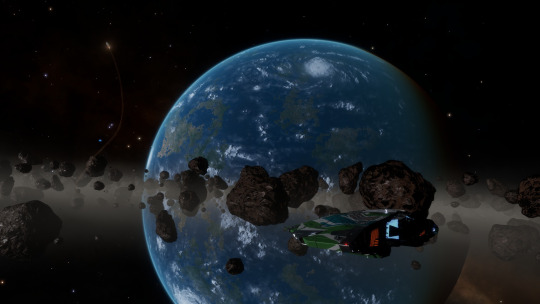
06 May 3309 Col 359 Sector KG-X D1-64, body 6F I think this moon may have once had an ocean, or some sort of liquid water, at least. The average temperature of 166K would no longer allow for that, but who knows, maybe it used to be warmer. I did find several plant samples at what seemed to be the bottom of a dried-up sea. No traces of specifically marine life, even in fossil form, however.
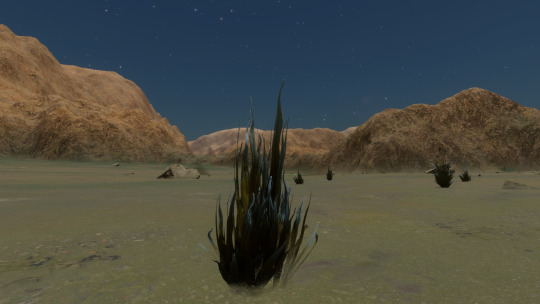
10 May 3309 R CrA Sector MI-S B4-6 The nebula I have chosen as my next destination is getting close, and it is easy to spot it with the naked eye now. I am quite excited, as I have never visited a nebula before! But let’s not get ahead of ourselves. This system was pretty interesting from an exobiological standpoint, I found several variants I had not encountered before, as well as a brand new (to me) genus, Clypeus. A small plant, with what seems to be a reflective, multi-coloured shell.
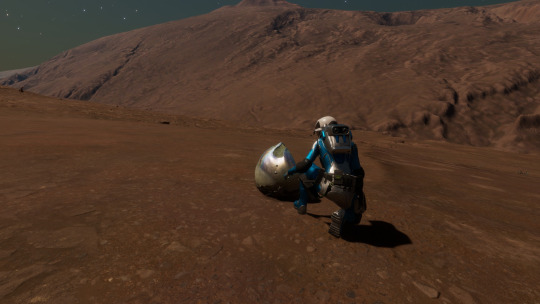
BrsO 14 I made it the the R CrA nebula! It is so pretty. I exited hyperspace facing a big blue star, then turned the ship around and found myself staring at a red sky. Absolutely mesmerising. Unfortunately, there was no planet for me to land on so I could admire the view from there, but I spent a good while just flying into the red cloud and observing it from all possible angles.
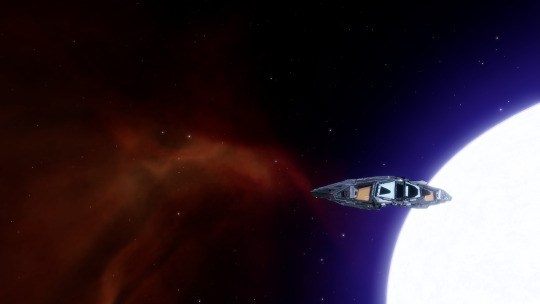
14 May 3309 PSR J1856-3754 I had seen there was a galactic curiosity a few jumps away, so I plotted a route to PSR J1856-3754, nicknamed "Coronet Pulsar". This one does not have one, but two neutron stars, separated by a mere 138 light-seconds. I will admit, I am still very nervous around those stars and I tend to keep my distances, but, maybe one day I will learn to dance with them.
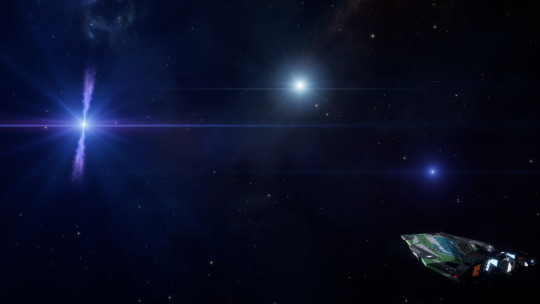
15 May 3309 Col 359 Sector UM-T c4-6 Made a quick stop by the CB-1 Argon’s Reach megaship. It was a little strange seeing human faces again. There were a few other explorers there, we traded stories and routes. Some of them had been in the Black for such a long time and honestly... it showed. Being hundreds and hundreds of light-years away from civilisation does something to you, I’m sure. I did make sure to upload the data and pictures I had recorded to Universal Cartographics, the procedure took longer than I expected, but I also don’t think I had ever tried to upload that much data at once.
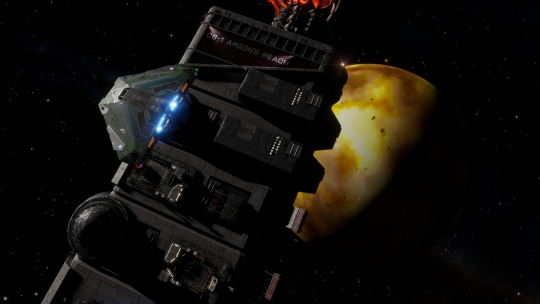
53 Nu Serpentis I am now officially back in human territory. I am not quite sure what led me here, but maybe it was just time.
17 May 3309 HIP 84913 Met a pilot named Ariel in a Type-9 Heavy, requesting some commodities. I’ll think about it and see if it’s anything I can find nearby. Which reminds me, I need to work on improving the Python’s FSD, there’s no way I’m going to be hauling any amount of goods in the Cobra’s 4-ton cargo hold. I love my Elmwing, but a trading ship she is not.

Laksak Took a shuttle to Laksak to retrieve the Python. My plan was to fly her back to HIP 84913, but... I am a butterfly with zero attention span... and I found myself doing exobiology sample collection in a Python. She managed alright, but I am very glad that most of the plants I found favoured flatter terrain, because I doubt I could have landed anywhere in the mountains.

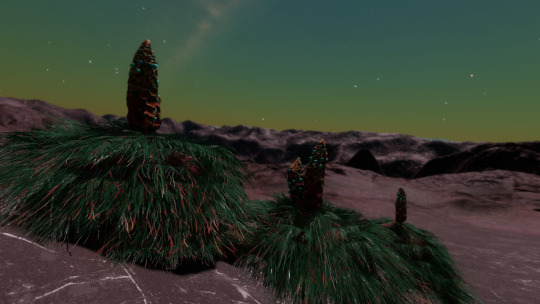
18 May 3309 HIP 84913 (again) Finally made it to my destination. Ariel the trader had already left, so I loaded up on limpets and decided to go mining instead. This first mining trip went pretty well overall. Not going to make a fortune until I figure out what to focus on, but it’s nice learning how to fly another ship and doing something else.

Speaking of different ships. I am now also the owner of a little Eagle I’m going to outfit to go canyon running... For now, her name is Birchtwig.
25 May 3309 Deciat I’ve taken both the Python and the Eagle to Felicity so that she could upgrade some of the modules. Birchtwig is now much faster (I outfitted her with enhanced performance thrusters, which Felicity said should be a good choice), and Cedarcone can now jump much farther. This should help reach mining spots and marketplaces a little faster.
Bruth This system was torn by civil war... Several ships tried to interdict me while I was mostly flying from one debris field to another, trying to salvage components, and maybe rescue a person or two. I did salvage some commodities that sold for a decent price in a neighbouring system, so I jumped there, and then also accepted a few surface delivery missions. Nothing complicated. A pilot called Ashley had apparently forgotten his personal documents before going on vacation at a tourist resort called Prieto’s Muse, in Njemari. He seemed relieved when he saw that I had brought them.
26 May 3309 Vard Argon atmospheres can bring such pretty lights. I don’t often land on those bodies because they tend to be found in systems with dim stars, and if they are distant enough, the surface is almost completely dark and I can’t see anything. But this... this was beautiful.
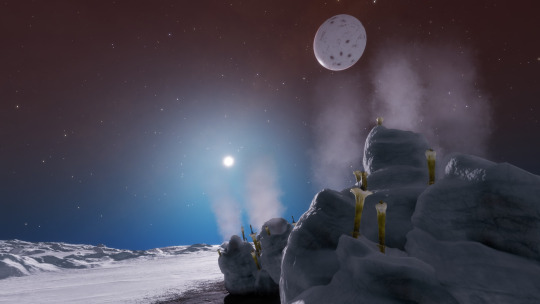
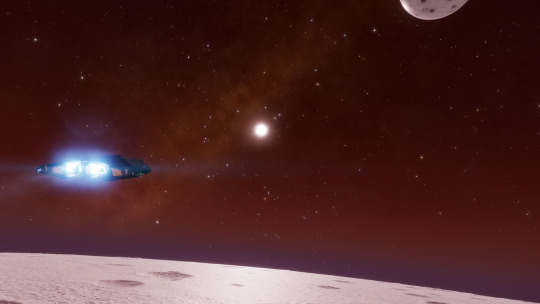
1 note
·
View note
Photo



Fabulous fossils in the Chedworth area
OUGS field trip, 2 July 2017
‘The old people are coming!’ A cohort of urchins, busily engaged in childish activities in Stony Furlong Quarry, thus greeted the arrival of the OUGS Severnside branch’s finest as we began a study tour in the Chedworth area.
Dr Paul Olver led this sortie into the Middle Jurassic, taking in two sections of railway cutting of the Midland & South Western Junction Railway to follow the succession of outcrops from the Great Oolite series in the quarry, dating from around 165 million years ago, to the older exposures near the Roman Villa.
First on the agenda was a cup of tea and the chance for breakfast at the Denfurlong Farm Shop – well worth remembering for future visits to the area. Then it was off to the cutting for a spot of hands-on geology, with fossils aplenty to be found in the rocks.
The White Limestone in the quarry proved a rich hunting ground whilst providing evidence of a marine environment, with the lower (softer and browner) rocks showing a more brackish environment with less biodiversity.
The fossil finds ranged from brachiopods and echinoids, plus one beautiful fish vertebra, to gastropods and bivalves. My personal favourite was a tiny but very lovely gastropod revealed in a crumbly piece of limestone I was able to pull apart, showing the creature and the impression on the opposite piece of stone.
From there we abandoned the urchins to their foraging and departed en masse on a picturesque drive to the car park by the Roman Villa. Lunch was a very civilised affair in the café at the National Trust property, before the party headed up into the woods and the second stretch of cutting.
This section of older rock dated from the Inferior Oolite Group (inferior only in the sense of lying beneath the Great Oolite Group), with echinoid fragments being the main attraction at our first stop, the Clypeus Grit.
Over the afternoon the group walked the length of the cutting, stopping at 10 locations to look for fossils and examine features including a tufa waterfall and a normal fault.
For me, as a relative newcomer to geology in the field, this was a great opportunity to see geologists in action and to have a range of people to chat to and question. The leisurely pace gave everyone the chance to have a good go at finding fossils – pick of the bunch were the fish vertebra, a beautiful bivalve like a razor shell, thalassinoides and Trigonia costata, shaped like a tricorn hat and featuring three sides with varying ornamentation – and to ask questions.
Best of all was just being able to chat to other members of the group about OU studies, geological activities around the area and field trips to far-flung areas of the globe.
Thanks to Paul for leading an excellent outing, and to the branch for putting on such a day trip. I’ve now acquired my latest piece of kit, a geological hammer, so I’m all set for the next one.
1 note
·
View note
Photo

CLYPEUS MULLERI Fossil Echinoid Sea Urchin Jurassic Inferior Oolite Wiltshire UK Authentic Specimen
This listing features a beautifully preserved fossil echinoid (sea urchin) of the species Clypeus mulleri, discovered in the Inferior Oolite Formation of Wiltshire, UK. This authentic Jurassic marine fossil is accompanied by a Certificate of Authenticity, and the photograph shows the actual specimen you will receive.
Clypeus mulleri is a well-known echinoid species from the Middle Jurassic and is part of the:
Order: Clypeasteroida
Family: Clypeidae
This echinoid lived during the Bajocian Stage of the Middle Jurassic Period, around 170–168 million years ago. The Inferior Oolite represents shallow marine environments, including oolitic and bioclastic limestones deposited in a warm, tropical sea.
Fossils from the oolite beds of Wiltshire are prized for their fine preservation and historical importance, with Clypeus mulleri being among the most characteristic species.
Morphological Features:
Large, rounded disc-shaped test with a slight central elevation
Petaloid ambulacra forming a five-petaled pattern on the upper surface
Fine radial symmetry with a smooth or lightly ornamented surface
Central peristome (mouth area) on the underside, typical of regular echinoids
These echinoids likely lived on or slightly buried in the sea floor, using tube feet for feeding and respiration.
Specimen Details:
Species: Clypeus mulleri
Fossil Type: Echinoid (Sea Urchin) Test
Geological Unit: Inferior Oolite Formation
Geological Age: Middle Jurassic (Bajocian Stage)
Location: Wiltshire, United Kingdom
Depositional Environment: Shallow warm marine platform (oolitic limestone)
Family: Clypeidae
This is a genuine and attractive example of a classic British Jurassic echinoid, perfect for fossil collectors, educators, or natural history enthusiasts.
Scale rule squares/cube = 1cm. Please see the photo for full sizing and details.
All of our Fossils are 100% Genuine Specimens & come with a Certificate of Authenticity.
#Clypeus mulleri fossil#Jurassic echinoid Wiltshire#fossil sea urchin UK#Inferior Oolite echinoid#Middle Jurassic fossil echinoderm#fossil marine invertebrate#Clypeus echinoid Jurassic#Wiltshire fossil Clypeus#authentic echinoid fossil#Bajocian sea urchin#Jurassic sea life UK#fossilised echinoid test#oolitic limestone fossil#UK Jurassic marine fossil#echinoderm collector specimen
0 notes
Photo

CLYPEUS PLOTTI Fossil Echinoid Sea Urchin Jurassic Inferior Oolite Cheltenham UK Authentic Specimen
This listing features a classic and well-preserved fossil echinoid (sea urchin) of the species Clypeus plotti, collected from the Inferior Oolite Formation, near Cheltenham, Gloucestershire, UK. This authentic Jurassic specimen comes with a Certificate of Authenticity, and the photos show the exact fossil you will receive.
Clypeus plotti is one of the most iconic echinoids of the British Jurassic. It is part of the:
Order: Clypeasteroida
Family: Clypeidae
These echinoids lived during the Bajocian Stage of the Middle Jurassic, approximately 170–168 million years ago. The Inferior Oolite Group, where this fossil was found, represents shallow marine carbonate platforms—a warm, tropical sea teeming with invertebrate life.
This region of the Cotswolds is famed for yielding some of the best-preserved specimens of Clypeus, which were once so common and distinctive that they were colloquially known as "pound stones" or "pound echinoids" due to their disc-like shape and abundance.
Morphological Features:
Large, thick discoidal test (shell) with a slightly domed profile
Central apical system with petaloid ambulacra
Radial symmetry with subtle ornamentation
Generally smooth surface with five faint petal-like grooves
These echinoids lived buried just beneath the sediment surface and were likely deposit feeders, sifting nutrients from the surrounding substrate.
Specimen Information:
Species: Clypeus plotti
Fossil Type: Echinoid (Sea Urchin) Test
Geological Unit: Inferior Oolite Formation
Geological Age: Middle Jurassic (Bajocian Stage)
Location: Cheltenham, Gloucestershire, UK
Depositional Environment: Shallow warm marine shelf (oolitic limestone)
Family: Clypeidae
This is an excellent specimen for any fossil enthusiast or collector of Jurassic marine invertebrates. It also makes a great educational example of Mesozoic echinoderm evolution and shallow marine ecosystems.
Scale rule squares/cube = 1cm. Please refer to the photos for full sizing and detail.
All of our Fossils are 100% Genuine Specimens & come with a Certificate of Authenticity.
#Clypeus plotti fossil#Jurassic sea urchin fossil#echinoid fossil Cheltenham#Clypeus echinoid Jurassic#Inferior Oolite fossil#UK Jurassic echinoid#fossil sea urchin with certificate#Cheltenham fossil echinoderm#Clypeus plotti sea urchin#Middle Jurassic fossil#echinoid collector specimen#genuine Jurassic echinoid#echinoderm fossil UK#fossil marine invertebrate#Jurassic echinoid UK
0 notes
Photo

CLYPEUS PLOTTI Fossil Echinoid Sea Urchin Jurassic Inferior Oolite Cheltenham UK Authentic Specimen
This listing features a classic and well-preserved fossil echinoid (sea urchin) of the species Clypeus plotti, collected from the Inferior Oolite Formation, near Cheltenham, Gloucestershire, UK. This authentic Jurassic specimen comes with a Certificate of Authenticity, and the photos show the exact fossil you will receive.
Clypeus plotti is one of the most iconic echinoids of the British Jurassic. It is part of the:
Order: Clypeasteroida
Family: Clypeidae
These echinoids lived during the Bajocian Stage of the Middle Jurassic, approximately 170–168 million years ago. The Inferior Oolite Group, where this fossil was found, represents shallow marine carbonate platforms—a warm, tropical sea teeming with invertebrate life.
This region of the Cotswolds is famed for yielding some of the best-preserved specimens of Clypeus, which were once so common and distinctive that they were colloquially known as "pound stones" or "pound echinoids" due to their disc-like shape and abundance.
Morphological Features:
Large, thick discoidal test (shell) with a slightly domed profile
Central apical system with petaloid ambulacra
Radial symmetry with subtle ornamentation
Generally smooth surface with five faint petal-like grooves
These echinoids lived buried just beneath the sediment surface and were likely deposit feeders, sifting nutrients from the surrounding substrate.
Specimen Information:
Species: Clypeus plotti
Fossil Type: Echinoid (Sea Urchin) Test
Geological Unit: Inferior Oolite Formation
Geological Age: Middle Jurassic (Bajocian Stage)
Location: Cheltenham, Gloucestershire, UK
Depositional Environment: Shallow warm marine shelf (oolitic limestone)
Family: Clypeidae
This is an excellent specimen for any fossil enthusiast or collector of Jurassic marine invertebrates. It also makes a great educational example of Mesozoic echinoderm evolution and shallow marine ecosystems.
Scale rule squares/cube = 1cm. Please refer to the photos for full sizing and detail.
All of our Fossils are 100% Genuine Specimens & come with a Certificate of Authenticity.
#Clypeus plotti fossil#Jurassic sea urchin fossil#echinoid fossil Cheltenham#Clypeus echinoid Jurassic#Inferior Oolite fossil#UK Jurassic echinoid#fossil sea urchin with certificate#Cheltenham fossil echinoderm#Clypeus plotti sea urchin#Middle Jurassic fossil#echinoid collector specimen#genuine Jurassic echinoid#echinoderm fossil UK#fossil marine invertebrate#Jurassic echinoid UK
0 notes
Photo

CLYPEUS PLOTTI Fossil Echinoid Sea Urchin Jurassic Inferior Oolite Cheltenham UK Authentic Specimen
This listing features a classic and well-preserved fossil echinoid (sea urchin) of the species Clypeus plotti, collected from the Inferior Oolite Formation, near Cheltenham, Gloucestershire, UK. This authentic Jurassic specimen comes with a Certificate of Authenticity, and the photos show the exact fossil you will receive.
Clypeus plotti is one of the most iconic echinoids of the British Jurassic. It is part of the:
Order: Clypeasteroida
Family: Clypeidae
These echinoids lived during the Bajocian Stage of the Middle Jurassic, approximately 170–168 million years ago. The Inferior Oolite Group, where this fossil was found, represents shallow marine carbonate platforms—a warm, tropical sea teeming with invertebrate life.
This region of the Cotswolds is famed for yielding some of the best-preserved specimens of Clypeus, which were once so common and distinctive that they were colloquially known as "pound stones" or "pound echinoids" due to their disc-like shape and abundance.
Morphological Features:
Large, thick discoidal test (shell) with a slightly domed profile
Central apical system with petaloid ambulacra
Radial symmetry with subtle ornamentation
Generally smooth surface with five faint petal-like grooves
These echinoids lived buried just beneath the sediment surface and were likely deposit feeders, sifting nutrients from the surrounding substrate.
Specimen Information:
Species: Clypeus plotti
Fossil Type: Echinoid (Sea Urchin) Test
Geological Unit: Inferior Oolite Formation
Geological Age: Middle Jurassic (Bajocian Stage)
Location: Cheltenham, Gloucestershire, UK
Depositional Environment: Shallow warm marine shelf (oolitic limestone)
Family: Clypeidae
This is an excellent specimen for any fossil enthusiast or collector of Jurassic marine invertebrates. It also makes a great educational example of Mesozoic echinoderm evolution and shallow marine ecosystems.
Scale rule squares/cube = 1cm. Please refer to the photos for full sizing and detail.
All of our Fossils are 100% Genuine Specimens & come with a Certificate of Authenticity.
#Clypeus plotti fossil#Jurassic sea urchin fossil#echinoid fossil Cheltenham#Clypeus echinoid Jurassic#Inferior Oolite fossil#UK Jurassic echinoid#fossil sea urchin with certificate#Cheltenham fossil echinoderm#Clypeus plotti sea urchin#Middle Jurassic fossil#echinoid collector specimen#genuine Jurassic echinoid#echinoderm fossil UK#fossil marine invertebrate#Jurassic echinoid UK
0 notes
Photo

CLYPEUS PLOTTI Fossil Echinoid Sea Urchin Jurassic Inferior Oolite Cheltenham UK Authentic Specimen
This listing features a classic and well-preserved fossil echinoid (sea urchin) of the species Clypeus plotti, collected from the Inferior Oolite Formation, near Cheltenham, Gloucestershire, UK. This authentic Jurassic specimen comes with a Certificate of Authenticity, and the photos show the exact fossil you will receive.
Clypeus plotti is one of the most iconic echinoids of the British Jurassic. It is part of the:
Order: Clypeasteroida
Family: Clypeidae
These echinoids lived during the Bajocian Stage of the Middle Jurassic, approximately 170–168 million years ago. The Inferior Oolite Group, where this fossil was found, represents shallow marine carbonate platforms—a warm, tropical sea teeming with invertebrate life.
This region of the Cotswolds is famed for yielding some of the best-preserved specimens of Clypeus, which were once so common and distinctive that they were colloquially known as "pound stones" or "pound echinoids" due to their disc-like shape and abundance.
Morphological Features:
Large, thick discoidal test (shell) with a slightly domed profile
Central apical system with petaloid ambulacra
Radial symmetry with subtle ornamentation
Generally smooth surface with five faint petal-like grooves
These echinoids lived buried just beneath the sediment surface and were likely deposit feeders, sifting nutrients from the surrounding substrate.
Specimen Information:
Species: Clypeus plotti
Fossil Type: Echinoid (Sea Urchin) Test
Geological Unit: Inferior Oolite Formation
Geological Age: Middle Jurassic (Bajocian Stage)
Location: Cheltenham, Gloucestershire, UK
Depositional Environment: Shallow warm marine shelf (oolitic limestone)
Family: Clypeidae
This is an excellent specimen for any fossil enthusiast or collector of Jurassic marine invertebrates. It also makes a great educational example of Mesozoic echinoderm evolution and shallow marine ecosystems.
Scale rule squares/cube = 1cm. Please refer to the photos for full sizing and detail.
All of our Fossils are 100% Genuine Specimens & come with a Certificate of Authenticity.
#Clypeus plotti fossil#Jurassic sea urchin fossil#echinoid fossil Cheltenham#Clypeus echinoid Jurassic#Inferior Oolite fossil#UK Jurassic echinoid#fossil sea urchin with certificate#Cheltenham fossil echinoderm#Clypeus plotti sea urchin#Middle Jurassic fossil#echinoid collector specimen#genuine Jurassic echinoid#echinoderm fossil UK#fossil marine invertebrate#Jurassic echinoid UK
0 notes
Photo

Clypeus ploti Fossil Echinoid - Jurassic, Chedworth Woods, Gloucestershire, UK | 100% Genuine Specimen + COA
A beautifully preserved Clypeus ploti Fossil Echinoid from the Clypeus Grit Member, Salperton Limestone Formation, Jurassic: Chedworth Woods, Gloucestershire, UK. This stunning echinoid fossil is an exceptional addition to any collection, perfect for collectors, educators, and enthusiasts.
✅ 100% Genuine Specimen – Every fossil we sell is authentic and comes with a Certificate of Authenticity. ✅ Discovered by our own expert team – This fossil was found on 22 December 2024 by our dedicated fossil hunters, Alister and Alison. ✅ Expertly cleaned, prepped, and treated – Professionally prepared by Alison to highlight its intricate details and natural structure. ✅ What you see is what you get – The listing photos show the exact specimen you will receive. ✅ Includes size reference – Scale cube in photos = 1cm. Please refer to the images for full dimensions.
About Clypeus ploti Fossil Echinoids:
Clypeus ploti is an extinct species of echinoid (sea urchin) from the Jurassic period, approximately 165 million years ago. These flattened, disc-like echinoids thrived in shallow marine environments and are commonly found in the Salperton Limestone Formation. Their unique shape and detailed preservation make them a highly sought-after fossil.
This piece is ideal for display, educational purposes, or as a unique gift for fossil lovers and paleontology enthusiasts!
Shipping & Packaging:
🔹 Securely packed for safe transit 🔹 Worldwide shipping available 🔹 Tracked & insured delivery options
Why Buy from Us?
🔹 Trusted Seller – Specializing in fossils, minerals, and natural history specimens. 🔹 Certified Authenticity – Every purchase includes a signed Certificate of Authenticity. 🔹 Ethically Sourced – All our fossils are legally and responsibly collected by our own team.
Bring a piece of prehistoric history into your collection today! 🦕🌍
#Clypeus ploti fossil#Jurassic echinoid#Clypeus Grit fossil#Salperton Limestone echinoid#Chedworth Woods fossil#Gloucestershire fossil#UK fossil#authentic echinoid#fossil collector#echinoid specimen#natural history#prehistoric fossil#fossilized echinoid#sea urchin fossil#geological specimen#unique fossil#fossil display#echinoid sale#echinoid decor#fossil hunting#genuine fossil#echinoid Jurassic#fossil shop#fossil enthusiast#fossil lover gift#rare echinoid#echinoid identification#echinoid UK#echinoid paleontology#echinoid for sale
0 notes
Photo

Clypeus ploti Fossil Echinoid - Jurassic, Chedworth Woods, Gloucestershire, UK | 100% Genuine Specimen + COA
A beautifully preserved Clypeus ploti Fossil Echinoid from the Clypeus Grit Member, Salperton Limestone Formation, Jurassic: Chedworth Woods, Gloucestershire, UK. This stunning echinoid fossil is an exceptional addition to any collection, perfect for collectors, educators, and enthusiasts.
✅ 100% Genuine Specimen – Every fossil we sell is authentic and comes with a Certificate of Authenticity. ✅ Discovered by our own expert team – This fossil was found on 22 December 2024 by our dedicated fossil hunters, Alister and Alison. ✅ Expertly cleaned, prepped, and treated – Professionally prepared by Alison to highlight its intricate details and natural structure. ✅ What you see is what you get – The listing photos show the exact specimen you will receive. ✅ Includes size reference – Scale cube in photos = 1cm. Please refer to the images for full dimensions.
About Clypeus ploti Fossil Echinoids:
Clypeus ploti is an extinct species of echinoid (sea urchin) from the Jurassic period, approximately 165 million years ago. These flattened, disc-like echinoids thrived in shallow marine environments and are commonly found in the Salperton Limestone Formation. Their unique shape and detailed preservation make them a highly sought-after fossil.
This piece is ideal for display, educational purposes, or as a unique gift for fossil lovers and paleontology enthusiasts!
Shipping & Packaging:
🔹 Securely packed for safe transit 🔹 Worldwide shipping available 🔹 Tracked & insured delivery options
Why Buy from Us?
🔹 Trusted Seller – Specializing in fossils, minerals, and natural history specimens. 🔹 Certified Authenticity – Every purchase includes a signed Certificate of Authenticity. 🔹 Ethically Sourced – All our fossils are legally and responsibly collected by our own team.
Bring a piece of prehistoric history into your collection today! 🦕🌍
#Clypeus ploti fossil#Jurassic echinoid#Clypeus Grit fossil#Salperton Limestone echinoid#Chedworth Woods fossil#Gloucestershire fossil#UK fossil#authentic echinoid#fossil collector#echinoid specimen#natural history#prehistoric fossil#fossilized echinoid#sea urchin fossil#geological specimen#unique fossil#fossil display#echinoid sale#echinoid decor#fossil hunting#genuine fossil#echinoid Jurassic#fossil shop#fossil enthusiast#fossil lover gift#rare echinoid#echinoid identification#echinoid UK#echinoid paleontology#echinoid for sale
0 notes
Photo

Clypeus ploti Fossil Echinoid - Jurassic, Chedworth Woods, Gloucestershire, UK | 100% Genuine Specimen + COA
A beautifully preserved Clypeus ploti Fossil Echinoid from the Clypeus Grit Member, Salperton Limestone Formation, Jurassic: Chedworth Woods, Gloucestershire, UK. This stunning echinoid fossil is an exceptional addition to any collection, perfect for collectors, educators, and enthusiasts.
✅ 100% Genuine Specimen – Every fossil we sell is authentic and comes with a Certificate of Authenticity. ✅ Discovered by our own expert team – This fossil was found on 22 December 2024 by our dedicated fossil hunters, Alister and Alison. ✅ Expertly cleaned, prepped, and treated – Professionally prepared by Alison to highlight its intricate details and natural structure. ✅ What you see is what you get – The listing photos show the exact specimen you will receive. ✅ Includes size reference – Scale cube in photos = 1cm. Please refer to the images for full dimensions.
About Clypeus ploti Fossil Echinoids:
Clypeus ploti is an extinct species of echinoid (sea urchin) from the Jurassic period, approximately 165 million years ago. These flattened, disc-like echinoids thrived in shallow marine environments and are commonly found in the Salperton Limestone Formation. Their unique shape and detailed preservation make them a highly sought-after fossil.
This piece is ideal for display, educational purposes, or as a unique gift for fossil lovers and paleontology enthusiasts!
Shipping & Packaging:
🔹 Securely packed for safe transit 🔹 Worldwide shipping available 🔹 Tracked & insured delivery options
Why Buy from Us?
🔹 Trusted Seller – Specializing in fossils, minerals, and natural history specimens. 🔹 Certified Authenticity – Every purchase includes a signed Certificate of Authenticity. 🔹 Ethically Sourced – All our fossils are legally and responsibly collected by our own team.
Bring a piece of prehistoric history into your collection today! 🦕🌍
#Clypeus ploti fossil#Jurassic echinoid#Clypeus Grit fossil#Salperton Limestone echinoid#Chedworth Woods fossil#Gloucestershire fossil#UK fossil#authentic echinoid#fossil collector#echinoid specimen#natural history#prehistoric fossil#fossilized echinoid#sea urchin fossil#geological specimen#unique fossil#fossil display#echinoid sale#echinoid decor#fossil hunting#genuine fossil#echinoid Jurassic#fossil shop#fossil enthusiast#fossil lover gift#rare echinoid#echinoid identification#echinoid UK#echinoid paleontology#echinoid for sale
0 notes
Photo

Rare Clypeus ploti Fossil Echinoid – Inferior Oolite, Jurassic, Banbury, Oxfordshire, UK | Authentic Specimen
Rare Clypeus ploti Fossil Echinoid – Inferior Oolite, Jurassic Period – Southworld Quarry, Banbury, Oxfordshire, United Kingdom
This listing features a rare Clypeus ploti fossil echinoid from the Inferior Oolite Formation of the Jurassic period, discovered at Southworld Quarry, Banbury, Oxfordshire, United Kingdom. This authentic specimen showcases the characteristic flat, disc-like shape and intricate surface features typical of the Clypeus genus.
About Clypeus ploti:
Clypeus ploti is an extinct species of echinoid, commonly referred to as a sea urchin, that thrived in the shallow seas of the Jurassic period. Known for its distinctive circular, flattened test (shell) with radial symmetry and fine surface details, Clypeus ploti is one of the most recognizable echinoid fossils found in the UK. These echinoids were slow-moving bottom dwellers, feeding on detritus in the seafloor sediment.
Geological Context:
Formation: Inferior Oolite
Age: Middle Jurassic (~174 – 164 million years ago)
Location: Southworld Quarry, Banbury, Oxfordshire, United Kingdom
The Inferior Oolite Formation is renowned for its fossil-rich limestone deposits, preserving a diverse range of marine life, including ammonites, bivalves, gastropods, and echinoids. The Middle Jurassic seas that covered Oxfordshire provided ideal conditions for the preservation of marine organisms like Clypeus ploti.
Fossil Details:
100% Genuine Clypeus ploti Fossil Echinoid
Age: Middle Jurassic (~174 – 164 million years ago)
Origin: Southworld Quarry, Banbury, Oxfordshire, United Kingdom
Well-Preserved Flat Disc Shape with Fine Surface Detailing
Scale Rule Squares/Cube = 1cm (Please refer to photos for full sizing)
Comes with a Certificate of Authenticity
From the esteemed Alice Purnell Collection, one of the world’s largest ammonite and marine fossil collections
Why This Specimen is Special:
Rare Jurassic Echinoid Fossil from the UK
Excellent preservation showcasing natural patterns and textures
Ideal for Collectors, Museums, or Educational Displays
Carefully selected for its geological and historical significance
A valuable addition to any fossil or natural history collection
This Clypeus ploti fossil echinoid is a stunning example of prehistoric marine life, offering a window into Earth’s ancient past. It is perfect for fossil enthusiasts, educators, and collectors.
📦 Fast & Secure Shipping 🛡️ 100% Authenticity Guaranteed 💎 A Premium Collector’s Fossil Specimen
Add this unique piece of Jurassic marine history to your collection today!
#Clypeus ploti#Fossil Echinoid#Jurassic Fossil#Inferior Oolite Fossil#Sea Urchin Fossil#UK Fossils#Banbury Fossils#Oxfordshire Fossils#Authentic Echinoid Fossil#Prehistoric Marine Life#Natural History Specimen#Fossil Collection#Museum Quality Fossil#Alice Purnell Collection#Geological Collectibles
0 notes
Photo

Rare Clypeus ploti Fossil Echinoid – Inferior Oolite, Jurassic, Banbury, Oxfordshire, UK | Authentic Specimen
Rare Clypeus ploti Fossil Echinoid – Inferior Oolite, Jurassic Period – Southworld Quarry, Banbury, Oxfordshire, United Kingdom
This listing features a rare Clypeus ploti fossil echinoid from the Inferior Oolite Formation of the Jurassic period, discovered at Southworld Quarry, Banbury, Oxfordshire, United Kingdom. This authentic specimen showcases the characteristic flat, disc-like shape and intricate surface features typical of the Clypeus genus.
About Clypeus ploti:
Clypeus ploti is an extinct species of echinoid, commonly referred to as a sea urchin, that thrived in the shallow seas of the Jurassic period. Known for its distinctive circular, flattened test (shell) with radial symmetry and fine surface details, Clypeus ploti is one of the most recognizable echinoid fossils found in the UK. These echinoids were slow-moving bottom dwellers, feeding on detritus in the seafloor sediment.
Geological Context:
Formation: Inferior Oolite
Age: Middle Jurassic (~174 – 164 million years ago)
Location: Southworld Quarry, Banbury, Oxfordshire, United Kingdom
The Inferior Oolite Formation is renowned for its fossil-rich limestone deposits, preserving a diverse range of marine life, including ammonites, bivalves, gastropods, and echinoids. The Middle Jurassic seas that covered Oxfordshire provided ideal conditions for the preservation of marine organisms like Clypeus ploti.
Fossil Details:
100% Genuine Clypeus ploti Fossil Echinoid
Age: Middle Jurassic (~174 – 164 million years ago)
Origin: Southworld Quarry, Banbury, Oxfordshire, United Kingdom
Well-Preserved Flat Disc Shape with Fine Surface Detailing
Scale Rule Squares/Cube = 1cm (Please refer to photos for full sizing)
Comes with a Certificate of Authenticity
From the esteemed Alice Purnell Collection, one of the world’s largest ammonite and marine fossil collections
Why This Specimen is Special:
Rare Jurassic Echinoid Fossil from the UK
Excellent preservation showcasing natural patterns and textures
Ideal for Collectors, Museums, or Educational Displays
Carefully selected for its geological and historical significance
A valuable addition to any fossil or natural history collection
This Clypeus ploti fossil echinoid is a stunning example of prehistoric marine life, offering a window into Earth’s ancient past. It is perfect for fossil enthusiasts, educators, and collectors.
📦 Fast & Secure Shipping 🛡️ 100% Authenticity Guaranteed 💎 A Premium Collector’s Fossil Specimen
Add this unique piece of Jurassic marine history to your collection today!
#Clypeus ploti#Fossil Echinoid#Jurassic Fossil#Inferior Oolite Fossil#Sea Urchin Fossil#UK Fossils#Banbury Fossils#Oxfordshire Fossils#Authentic Echinoid Fossil#Prehistoric Marine Life#Natural History Specimen#Fossil Collection#Museum Quality Fossil#Alice Purnell Collection#Geological Collectibles
0 notes
Photo

Rare Clypeus ploti Fossil Echinoid – Inferior Oolite, Jurassic, Banbury, Oxfordshire, UK | Authentic Specimen
Rare Clypeus ploti Fossil Echinoid – Inferior Oolite, Jurassic Period – Southworld Quarry, Banbury, Oxfordshire, United Kingdom
This listing features a rare Clypeus ploti fossil echinoid from the Inferior Oolite Formation of the Jurassic period, discovered at Southworld Quarry, Banbury, Oxfordshire, United Kingdom. This authentic specimen showcases the characteristic flat, disc-like shape and intricate surface features typical of the Clypeus genus.
About Clypeus ploti:
Clypeus ploti is an extinct species of echinoid, commonly referred to as a sea urchin, that thrived in the shallow seas of the Jurassic period. Known for its distinctive circular, flattened test (shell) with radial symmetry and fine surface details, Clypeus ploti is one of the most recognizable echinoid fossils found in the UK. These echinoids were slow-moving bottom dwellers, feeding on detritus in the seafloor sediment.
Geological Context:
Formation: Inferior Oolite
Age: Middle Jurassic (~174 – 164 million years ago)
Location: Southworld Quarry, Banbury, Oxfordshire, United Kingdom
The Inferior Oolite Formation is renowned for its fossil-rich limestone deposits, preserving a diverse range of marine life, including ammonites, bivalves, gastropods, and echinoids. The Middle Jurassic seas that covered Oxfordshire provided ideal conditions for the preservation of marine organisms like Clypeus ploti.
Fossil Details:
100% Genuine Clypeus ploti Fossil Echinoid
Age: Middle Jurassic (~174 – 164 million years ago)
Origin: Southworld Quarry, Banbury, Oxfordshire, United Kingdom
Well-Preserved Flat Disc Shape with Fine Surface Detailing
Scale Rule Squares/Cube = 1cm (Please refer to photos for full sizing)
Comes with a Certificate of Authenticity
From the esteemed Alice Purnell Collection, one of the world’s largest ammonite and marine fossil collections
Why This Specimen is Special:
Rare Jurassic Echinoid Fossil from the UK
Excellent preservation showcasing natural patterns and textures
Ideal for Collectors, Museums, or Educational Displays
Carefully selected for its geological and historical significance
A valuable addition to any fossil or natural history collection
This Clypeus ploti fossil echinoid is a stunning example of prehistoric marine life, offering a window into Earth’s ancient past. It is perfect for fossil enthusiasts, educators, and collectors.
📦 Fast & Secure Shipping 🛡️ 100% Authenticity Guaranteed 💎 A Premium Collector’s Fossil Specimen
Add this unique piece of Jurassic marine history to your collection today!
#Clypeus ploti#Fossil Echinoid#Jurassic Fossil#Inferior Oolite Fossil#Sea Urchin Fossil#UK Fossils#Banbury Fossils#Oxfordshire Fossils#Authentic Echinoid Fossil#Prehistoric Marine Life#Natural History Specimen#Fossil Collection#Museum Quality Fossil#Alice Purnell Collection#Geological Collectibles
1 note
·
View note